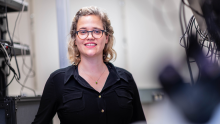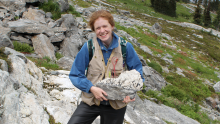Iceland’s geothermal hotsprings and majestic glaciers are attracting a new type of adventure seeker to the small island nation.
ISCI 361 – an intensive, three-week field course launched this May by UBC – takes science students to the nordic country and offers them a broad, in situ view of sustainability issues. Iceland’s dramatic geological features, geothermal and hydroelectric energy infrastructure, unique climate, and cultural and political influences serve as a self-contained living lab for the third-year class.
“When people ask me how Iceland was, it’s difficult to describe,” says Erica Hunter, a third-year biology student who embarked on the class this spring with 12 other science and forestry students. “The words that come to mind are dynamic, unique, and overall, epic.”
“Many students don’t get an opportunity to do something like this – a field course in a foreign country, an opportunity to learn about the powers of nature as they happen in situ, and to experience a new culture simultaneously.”
Hunter describes how questions about issues were answered “right then and there” with details on the location’s or topic’s current development or politics woven in on the spot.
“The wonderful thing about Iceland is that it’s big enough so there is a lot of complexity, but not too big,” says course instructor Lee Groat, professor with Earth, Ocean and Atmospheric Sciences and director of the Integrated Sciences program. “So it’s an ideal learning environment.”
During their first run-through of the course, the 12 students explored a wide variety of topics, including glaciology, volcanic activity, sustainable agriculture, economics, developments in sustainable energy such as hydrogen, biofuels, geothermal energy and more.
Students found themselves touring the Svartsengi geothermal energy plant followed by a dip in naturally heated rivers and the dreamy Blue Lagoon. They learned from residents as well as from local researchers at the University of Iceland while also observing science in action – a rare learning opportunity for undergraduate students.
“When you live in the place you’re studying, you gain a deeper understanding of the material and a wealth of memories,” says Piper-Lynn Brady, a third-year environmental sciences student. “We were asked to not only have a deep scientific understanding of each topic and the systemic relationship between topics, but also the social systems in which they are embedded.”
“We don’t take a deep focus in any single area such as energy systems or climate change, which had much relevance in a place such as Iceland,” says Leah Macfadyen, who developed the course and is also an instructor in the Integrated Sciences program. “Rather it looks at a range of topics within the sustainability of science.”
With ISCI 361’s inaugural trip successfully completed, the course will likely be held in Iceland next May – with plans to travel to different destinations around the world in following years. A major goal, says Groat, is to create a template that touches on themes that are relevant to a variety of locations.
“We could, for example, visit a town in Kansas to study how health is impacted by ground water conditions in small towns. Then once we have a good understanding, we can come back to Vancouver and try applying what we’ve learned right here.”
ISCI 361 Student Blog
http://blogs.ubc.ca/isci361
Go Global
http://www.students.ubc.ca/global/learning-abroad/group-study-programs/…
Musqueam First Nation land acknowledegement
We honour xwməθkwəy̓ əm (Musqueam) on whose ancestral, unceded territory UBC Vancouver is situated. UBC Science is committed to building meaningful relationships with Indigenous peoples so we can advance Reconciliation and ensure traditional ways of knowing enrich our teaching and research.
Learn more: Musqueam First Nation
Faculty of Science
Office of the Dean, Earth Sciences Building2178–2207 Main Mall
Vancouver, BC Canada
V6T 1Z4


